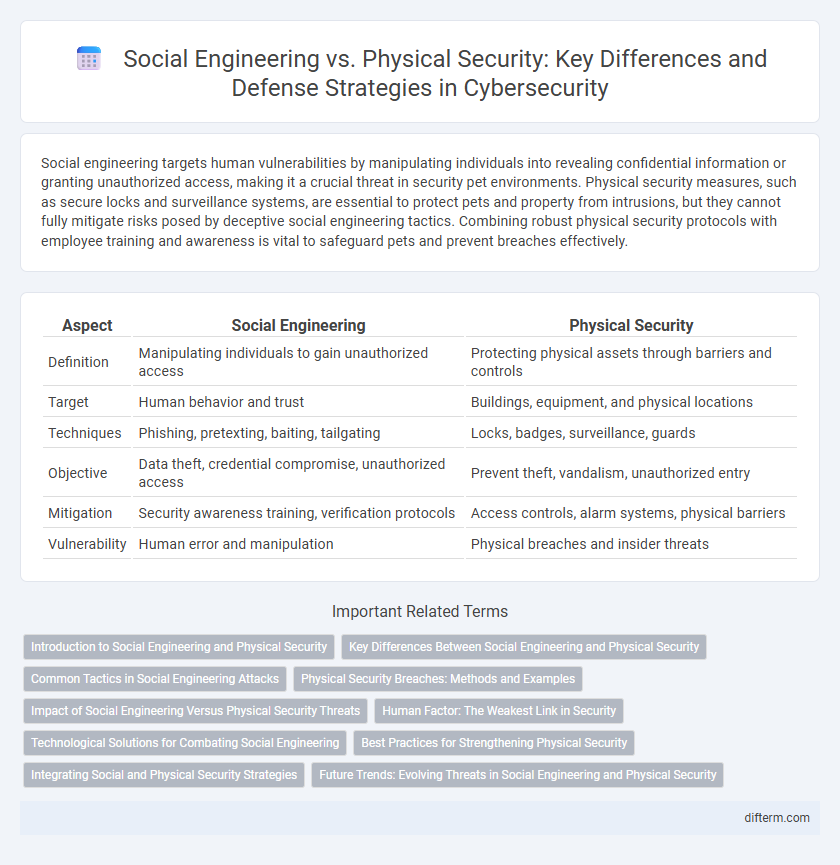Social engineering targets human vulnerabilities by manipulating individuals into revealing confidential information or granting unauthorized access, making it a crucial threat in security pet environments. Physical security measures, such as secure locks and surveillance systems, are essential to protect pets and property from intrusions, but they cannot fully mitigate risks posed by deceptive social engineering tactics. Combining robust physical security protocols with employee training and awareness is vital to safeguard pets and prevent breaches effectively.
Table of Comparison
| Aspect | Social Engineering | Physical Security |
|---|---|---|
| Definition | Manipulating individuals to gain unauthorized access | Protecting physical assets through barriers and controls |
| Target | Human behavior and trust | Buildings, equipment, and physical locations |
| Techniques | Phishing, pretexting, baiting, tailgating | Locks, badges, surveillance, guards |
| Objective | Data theft, credential compromise, unauthorized access | Prevent theft, vandalism, unauthorized entry |
| Mitigation | Security awareness training, verification protocols | Access controls, alarm systems, physical barriers |
| Vulnerability | Human error and manipulation | Physical breaches and insider threats |
Introduction to Social Engineering and Physical Security
Social engineering exploits human psychology to manipulate individuals into divulging confidential information or granting unauthorized access, posing significant risks to organizational security. Physical security involves measures such as access controls, surveillance, and environmental design to protect assets and prevent intrusion or damage. Understanding the interplay between social engineering tactics and physical security protocols is essential for developing comprehensive defense strategies against security breaches.
Key Differences Between Social Engineering and Physical Security
Social engineering exploits human psychology to manipulate individuals into revealing confidential information or granting unauthorized access, whereas physical security relies on tangible barriers like locks, surveillance, and access controls to protect assets. Social engineering attacks often involve phishing, pretexting, or impersonation, targeting human vulnerabilities, while physical security addresses risks such as unauthorized entry, theft, or vandalism through security systems and personnel. Understanding these key differences helps organizations design comprehensive security strategies that integrate both human factor defenses and physical protective measures.
Common Tactics in Social Engineering Attacks
Social engineering attacks commonly rely on tactics such as phishing, pretexting, baiting, and tailgating to manipulate individuals into divulging confidential information or granting unauthorized access. Attackers often exploit human psychology by creating a sense of urgency, trust, or curiosity to bypass physical security measures. Recognizing these techniques is crucial for enhancing overall security protocols and preventing breaches.
Physical Security Breaches: Methods and Examples
Physical security breaches often occur through unauthorized access methods such as tailgating, lock picking, and badge cloning, enabling intruders to bypass secure entry points. Common examples include forced entry using tools like crowbars, exploitation of unsecured doors or windows, and tampering with security systems such as surveillance cameras or alarm sensors. These breaches can lead to theft, data compromise, and disruption of critical infrastructure in corporate and government facilities.
Impact of Social Engineering Versus Physical Security Threats
Social engineering exploits human psychology to gain unauthorized access, often bypassing physical security measures and leading to data breaches, financial fraud, and identity theft. Physical security threats, such as unauthorized entry or theft, directly compromise tangible assets and infrastructure, causing immediate operational disruptions and potential safety hazards. The impact of social engineering typically results in more pervasive and long-term damage due to compromised information systems, whereas physical security breaches tend to have immediate but localized effects on physical assets.
Human Factor: The Weakest Link in Security
Social engineering exploits the human factor by manipulating individuals into revealing confidential information or granting unauthorized access, highlighting it as the weakest link in security frameworks. Physical security measures can be robust, but without proper employee training and awareness, humans remain vulnerable to deception and insider threats. Strengthening human vigilance through behavioral analytics and continuous education significantly mitigates risks associated with social engineering attacks.
Technological Solutions for Combating Social Engineering
Technological solutions for combating social engineering include advanced email filtering systems, multi-factor authentication (MFA), and AI-powered behavior analysis to detect unusual patterns indicative of phishing or impersonation attempts. Endpoint security tools with machine learning algorithms monitor device interactions and block malicious activities before they can exploit human vulnerabilities. Security Information and Event Management (SIEM) platforms integrate data from various sources, providing real-time threat intelligence to prevent social engineering attacks targeting physical security infrastructure.
Best Practices for Strengthening Physical Security
Implementing strong access control systems, such as biometric scanners and keycard entry, significantly improves physical security by restricting unauthorized access. Regular employee training on identifying suspicious behavior and enforcing strict visitor protocols helps mitigate the risk posed by social engineering tactics. Integrating surveillance technology with real-time monitoring and quick response plans enhances overall facility protection against physical breaches.
Integrating Social and Physical Security Strategies
Integrating social engineering awareness with physical security measures strengthens overall organizational defense by addressing both human and environmental vulnerabilities. Combining employee training on recognizing manipulation tactics with robust access controls and surveillance systems creates a comprehensive security posture. Prioritizing this integration reduces risks from insider threats and unauthorized physical access, ensuring a holistic approach to security management.
Future Trends: Evolving Threats in Social Engineering and Physical Security
Emerging trends in social engineering reveal an increase in sophisticated AI-driven phishing and deepfake-based scams, requiring enhanced digital authentication measures and employee training. Physical security is evolving with biometric advancements, cybersecurity integration, and IoT-enabled surveillance systems to counteract rising hybrid threats that blend digital and physical tactics. Organizations must adopt adaptive, multi-layered defense strategies combining behavioral analytics and real-time threat intelligence to effectively mitigate these converging risks.
Social Engineering vs Physical Security Infographic

 difterm.com
difterm.com